ABSTRACT
BACKGROUND
To find out the prevalence and to highlight the risk factors of low back pain in home-based physical therapist.
STUDY DESIGN AND SAMPLING TECHNIQUE
A cross-sectional survey study with non-probability convenience sampling Technique
STUDY SETTING AND PARTICIPANTS
200 physical therapists that were doing home patients in Karachi, either without or with their jobs were the part of this study. They were either self-employed or affiliated to different hospitals.
DATA COLLECTING TOOL AND DATA ANALYSIS
A questionnaire was used to collect data, which was adopted from Nordic questionnaire and other researches. The collected data was analyzed on SPSS 20.
RESULTS
93 % home-based physical therapists had experienced the work-related pain or discomfort in the last 12 months. Among them the low back is the highly affected site with prevalence of 81.5%. Their working status of job in physical therapy department or academics with home-based physical therapy had a significant difference in presence or absence of work-related pain or discomfort.
CONCLUSION
This study shows that home-based physical therapists are more prone to develop work-related problems and had higher prevalence of work-related LBP. This may be due to more work load, lower bed height of home patients, poor ergonomics at homes of patients and poor posture of physical therapists.
Key Words
Home-based Physical Therapists, Home-based Physical Therapy Services, Work-related Low Back Pain, Work-related Musculoskeletal Pain or Discomfort, Home Visits, Physical Therapy Departments, Ergonomics
Ghazala Noor Nizami
Assistant Professor
Ziauddin College of Physical Therapy
Ziauddin University
Muhammad Sarfraz
Assistant Professor
Ziauddin College of Physical Therapy
Ziauddin University
Dr. Shazia Noor Nizami
Medical Practitioner
Nizami Medical Center
[Nizami GN, Sarfraz M, Nizami SN. Prevalence of Low Back Pain in Home-Based Physical Therapists. Pak. j. rehabil. 2013;2(1):15-20]
INTRODUCTION
Musculoskeletal disorders (MSDs) are common worldwide. Among them, work-related MSDs are very important. Risk factors associated with work place play a major role in development of work-related MSDs of different body areas1,2. The personal, psychosocial, physical and ergonomic factors are associated with them. Researches focused many fields of work to find out its occurrence in that work and many found Low Back as the most common affected site. Low back pain (LBP) is a very common health issue of general population as well as populace of every profession, including health care providers 3,4. 62-80% of general population suffers from this agony in their lives3. Both men and women are affected evenly. However, variation occurs in the age of both genders. It occurs mostly in men at an average age of 40, and more in elder women3. In industrial population, LBP results in loss of work time, disability either temporary or permanent3. LBP leads to absenteeism from work4. Ultimately, these organizations have more losses due to increased absenteeism, turn over and decreased productivity. Other than industrial workers it is also common in nurses, varying with age, length of employment, handling techniques5.
Studies conducted to find out the prevalence of work-related musculoskeletal problems in nurses, surgeons and doctors, revealed LBP as 46.8% in nurses, 68.1% in surgeons and 36.84% in doctors 5-10.
Among the health care providers, physical therapists are also prone to develop different work-related musculoskeletal problems, including low back pain3,4,11-25. Similar work has been done by Siqueira GR et al. who found that 78.58% physical therapist in the city of Recife, Brazil had complaint of LBP4. Babatunde OA et al. also reported 91.3% prevalence of Work-related musculoskeletal disorders among Nigerian Physiotherapists. In this study 69.8% has the involvement of low back was and 34.1% had neck involvement.
50% Physiotherapists had this agony within 5 years of graduation and 61.7% were below 30 years of age16.BuddhadevNeeti P found the 69% physiotherapists had WRMDs and 35% has this at low back25. Glover found that 68% members of the Chartered Society of Physiotherapy (CSP) had work-related musculoskeletal disorders. Among them, 58% had this in last 12 months and 42% had symptoms for more than three days. 44% had problem in low back11.
Various studies have shown the prevalence of low back pain and WRMD among foreign population but this study has focused only those physical therapists that provide home-based physical therapy services, either with or without their separate job. This study is aimed to find out the prevalence and to highlight the risk factors of low back pain in home-based physical therapist. To best of my knowledge, there is no data available about the prevalence of low back pain among home-based physical therapist of our population.
METHODOLOGY
Study Design
This study was a cross-sectional survey study.
Sampling Technique
Convenience Non-probability Sampling technique was used to collect data.
Study Setting and Participants
The data was collected from 200 physical therapists. Physical therapists that were doing home patients in Karachi, either without or with their jobs were the part of this study. They were either self-employed or affiliated to different hospitals.
Study Duration
Six months.
Inclusion and Exclusion Criteria
Both male and female physical therapists of age 25-60 years, providing home-based physical therapy services to patients were included in the study. Physical therapists who did not want to participate were excluded from this data.
Data Collecting Tool
A questionnaire was used to collect data. The questionnaire consists of questions about general information of age, gender, working status, work load, years of working, works other home-based therapy, number of home patients, and details about low back problems. Questions of this questionnaire were adopted from Nordic questionnaire and other researches16, 18,21,26,27.
Ethical Consideration
Before filling the questionnaire, study was explained to them and written consent was taken. Their personal information was kept confidential.
Data Analysis
The collected data was analyzed on SPSS 20. General information about socio-demographic characteristics were shown in Mean (Standard Deviation) and percentages. The descriptive and occupational characteristics were shown in percentages, Fisher’s exact tests and Chi-square statistics.
RESULT
Two hundred home-based physical therapists filled the questionnaire, with mean age of 34.27 ± 5.29 years, ranging from 26 to 52 years. Among them 9(4.5%) were females and 191 (95.5%) were males. Their average years of Physical therapy experience were 9.27 ± 5.29 years, ranging from 1 to 27 years. General information of physical therapists that were doing home-visits is shown in Table 1.
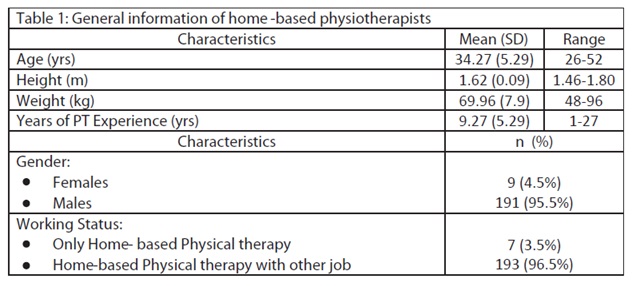
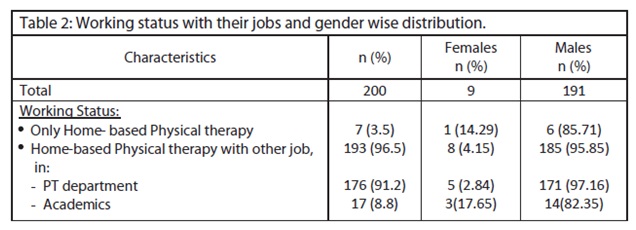
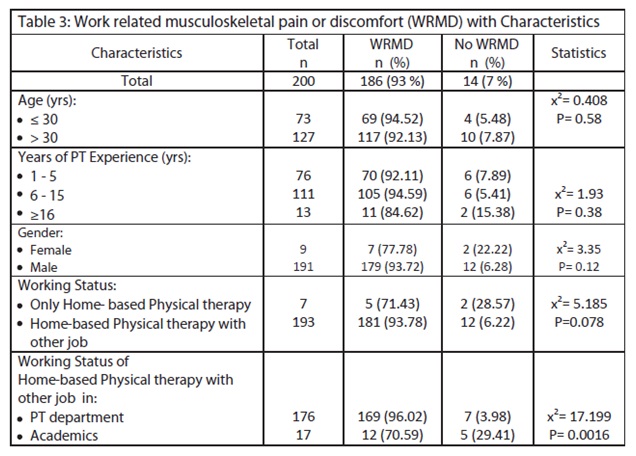
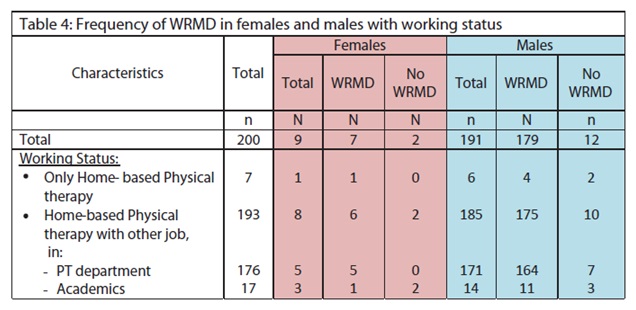
Remaining 2% physical therapists told that they worked on only that bed height which suits them by making adjustments, when they not found the correct bed height. Out of 200 physical therapists, 64 (32%) told that the height of bed of their most of home patients were at the level of their knee, 133 (66.5%) reported it between the knee and hip.
It is found that 186 (93 %) from 200 physical therapists had experienced the work-related pain or discomfort in the last 12 months. Their characteristics with presence or absence of any work-related pain or discomfort is shown in Table 3. Their working status of job in physical therapy department or academics with home-based physical absence of work-related musculoskeletal pain or discomfort (WRMD). Table 4 showed the frequency of Work-related musculoskeletal pain or discomfort (WRMD) in females and males with working status.
Among the 186 physical therapists who had experienced work-related musculoskeletal pain or discomfort in the last 12 months, 81.5 % reported the low back as the most vulnerable area where neck (34.5%), shoulder/arm (22%) and other regions/sites were also reported (Table 5).
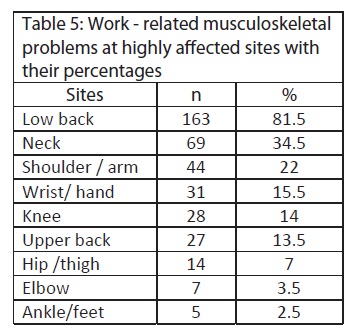
Regarding the onset of low back pain (LBP), 141 (86.5%) physical therapists had gradual onset, while 21 (12.88%) had sudden. 1 (0.61%) had accident which caused LBP (Table 6).
When asked about parting of their home-based physical therapy services, 144 (88.34%) out of 163 had not left the home-based physiotherapy, while 19 prevented them for 1-7 days from doing their normal work. 52 (31.9%) had changed or modified their treatment techniques for patients (Table 7).
The prevalence of work-related musculoskeletal problems at highly affected sites with their percentages from three different studies is shown in the table8 16,18,25.
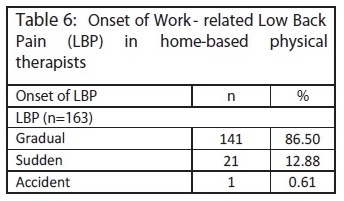
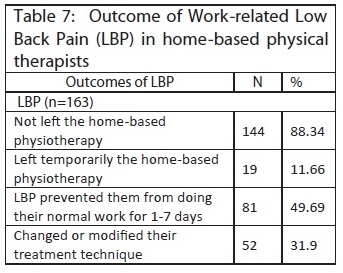

DISCUSSION
Higher intensity of physical work with poor ergonomics leads to Low back pain (LBP). Physical workers with improper lifting and carrying, and poor postures will develop LBP and other problems.
Lifting and carrying techniques with its frequency, amount of load, time spend in a static posture or activity, bending, reaching, work load, vibration, work-place and many other factors with age and sex are important for work-related musculoskeletal disorders including LBP. Many researches focused to find the prevalence, incidence, causes and risk factors of low back pain and to find the preventive measures for work-related low back pain.
Numerous studies have shown the high prevalence of low back pain among physical therapists of foreign population. Most of the home-based physical therapist of our population treat patients in physical therapy departments and/or involve in academic activities during their job hours. They provide home-based services privately before or after their job duties, which ultimately increase the work load on them. Most of the patients who take therapy at home are bed ridden or dependent. Physical therapists mostly compromise with the ergonomic factors, especially bed height. For comparison no data is available about work-related problems of home-based physical therapist of our population.
This study has shown that home-based physical therapists had more work-related low back pain (93%) than result of other studies. In other studies, the Prevalence of Low back pain was found 44% in members of the Chartered Society of Physiotherapy (CSP) by Glover et al11, 78.58% by Siqueira GR et al in physical therapist of Brazil4, 73.7% in physical therapists by Rugelj D18, 45% in physical therapists by Bork et al20, 26 % in physical therapists of Izmir-Turkey by Salik Y et al21, 69.8% in Nigerian physical therapists by Babatunde OA et al16, 70% in physical therapists (61.8% in males, 74.2% in females) by Shehab D24, 29% in physical therapists by Molumphy et al3, 62% in physical therapists and 56% in physical therapy assistants by Holder NL et al15, 46.8% in nurses by Dehlin O et al6, 68.1% in surgeons by Grace et al9, 36.84% Salvi Shah & Beena Dave in doctors of Surat10. Naude, Benita found 47%-point prevalence for LBP in nurses8.
Cromie JE et al studied the attitudes and beliefs of therapists that had WRMD and also found 91% life time prevalence of WMSD 22,23. Scholey et al studied Back pain in physiotherapists involved in back care education19. West DJ et al studied occupational injuries of physiotherapists in North and Central Queensland, found that 55% physiotherapists had work-related injury, primarily of low back, hands and neck17. Among them 56% initial episodes were within 5 years of graduation. After occupational injury, 38% therapists had changed ther work setting, while most had changed their techniques17.
Comparison of this study with three studies in detail is shown in the table 8,16,18,25. These three studies were done on physical therapists working in physiotherapy departments. As my study is based on home-based physical therapist which did home-patients with or without their job duties, may be due to this reason the prevalence of work-related problems are higher than these studies. Buddhadev Neeti et al found that 20 (69%) out of 29 physical therapists had developed WRMD and 35% had LBP25, which is a very low value than other studies and may be due to less sample size.
Physical therapists having work- related problems, especially the LBP thought that lower bed height, poor ergonomics in patients’ home and their poor posture due to it, were the main reasons of their low back pain and other problems.
There could be one more reason that physical therapists have to treat more patients. They try to save the time by avoiding the ergonomics and by ignoring their own health, which will also prone to develop work-related problems.
Male physical therapists are doing predominantly more home visits than female physical therapists in our population. Females have many casual factors of LBP including pregnancy, number of deliveries etc. Among the data from these 9 female physical therapists, it is difficult to say that cause of LBP was totally related to home visits or not.
Guidelines to prevent and manage low back pain at work place are established and available. If the guidelines and proper ergonomics are followed, then physical therapists can decrease the risk of low back pain and eventually its outcomes28-30.
CONCLUSION
This study shows that home-based physical therapists are more prone to develop work-related problems and had higher prevalence of work-related LBP. This may be due to more work load, lower bed height of home patients, poor ergonomics at homes of patients and poor posture of physical therapists.
REFERENCE
- Hales TR, Bernard BP. Epidemiology of work-related musculoskeletal disorders. OrthopClin North Am. 1996 Oct;27(4):679-709
- Punnett L, Wegman DH. Wegman. Work-related musculoskeletal disorders: the epidemiologic evidence and the debate. J Electromyogr Kinesiol. 2004 Feb;14 (1):13-23.
- Molumphy M, Unger B, Jensen GM, Lopopolo RB. Incidence of work-related low back pain in physical therapists. Phys Ther. 1985Apr; 65(4): 482-6.
- Siqueira GR, Cahú FGM, Vieira RAG. Occurrence of low back pain in physical therapists from the city of Recife, Pernambuco, Brazil. Braz. J. Phys. Ther. Rev Bras Fisioter. 2008;12(3):222-7.
- Cust G, Pearson JC, Mair A. The prevalence of low back pain in nurses. International nursing review. 1972;19(2):169-79.
- Dehlin O, Hedenrud B, Horal J. Back symptoms in nursing aides in a geriatric hospital. An interview study with special reference to the incidence of low-back symptoms. Scand J Rehabil Med.1976;8(2):47-53.
- Habibi E, Pourabdian S, Atabaki AK, Hoseini M. Evaluation of Work-related Psychosocial and Ergonomics Factors in Relation to Low Back Discomfort in Emergency Unit Nurses. Int J Prev Med. 2012 August; 3(8): 564–568.
- Naude, Benita. Factors associated with low back pain in hospital employees. Electronic Theses and Dissertations (ETD). Available with full text from:. http://hdl.handle.net/ 10539 /6949.
- Grace P. Y. Szeto, Pei Ho, Albert C. W. Ting, Jensen T. C. Poon, Stephen W. K. Cheng, Raymond C. C. Tsang. Work-related Musculoskeletal Symptoms in Surgeons. Journal of Occupational Rehabilitation. June 2009;19(2):175-184.
- Salvi Shah, Beena Dave. Prevalence of Low Back Pain and Its Associated Risk Factors among Doctors in Surat. International Journal of Health Sciences & Research (IJHSR). April 2012;2(1):91-102.
- Glover W, McGregor A, Sullivan C, Hague J. Workrelated musculoskeletal disorders affecting memmbers of the Chartered Society of Physiotherapy. Physiotherapy 2005; 91(3):138-147
- Mierzejewski M, Kumar S. Prevalence of low back pain among physical therapists in Edmonton, Canada. Disabil Rehabil. 1997 Aug;19(8):309-17.
- Campo M, Darragh AR. Impact of work-related pain on physical therapists and occupational therapists. Phys Ther. 2010Jun; 90(6):905-20.
- Passier L, McPhail S. Work related musculoskeletal disorders amongst therapists in physically demanding roles: qualitative analysis of risk factors and and strategies for prevention. BMC Musculoskelet Disord. 2011 Jan 25;12:24. doi:10.1186/1471-2474- 12-24.
- Holder NL, Clark HA, DiBlasio JM, Hughes CL, Scherpf JW, Harding L, et al. Cause, prevalence, and response to occupational musculoskeletal injuries reported by physical therapists and physical therapist assistants. Phys Ther. 1999;79 (7):642-52.
- Babatunde OA Adegoke, Ashiyat K Akodu, Adewale L Oyeyemi. Work-related musculoskeletal disorders among Nigerian Physiotherapists. BMC Musculoskeletal Disorders 2008, 9:112 doi:10.1186/1471-2474-9-112
- West DJ, Gardner D. Occupational injuries of physiotherapists in North and Central Queensland. The Australian journal of physiotherapy. 2001;47(3):179-86.
- Rugelj D. Low back pain and other work-related musculoskeletal problems among physiotherapists. Appl Ergon. 2003 Nov;34(6):635-9.
- Scholey M, Hair M. Back pain in physiotherapists involved in back care education. Ergonomics. 1989 Feb; 32(2):179–190.
- Bork BE, Cook TM, Rosecrance JC, et al. Workrelated musculoskeletal disorders among physical therapists. Phys Ther. 1996 Aug;76(8):827–835
- Salik Y, Ozcan A. Work-related musculoskeletal disorders : A survey of physical therapists in Izmir-Turkey. BMC Musculoskeletal Disorders 2004 Aug; 18;5:27. doi:10.1186/1471-2474-5-27
- Cromie JE, Robertson VJ, Best MO. Work-related musculoskeletal disorders and the culture of physical therapy. Phys Ther. 2002;82(5): 459-72.
- Cromie JE, Robertson VJ, Best MO. Work-related musculoskeletal disorders in physical therapists: prevalence, severity, risks, and responses. Phys Ther. 2000; 80(4):336-51.
- Sehab D, Al-Jarallah K, Moussa MA, Adham N. Prevalence of Low Back Pain among Physical Therapists in Kuwait. Med Princ Pract. 2003;12(4):224–230.
- Buddhadev Neeti P, KotechaIlesh S. Work-related musculoskeletal disorders: A survey of physiotherapists in saurashtra Region. Natl J Med Res. 2012;2(2):179-181
- Kuorinka I, Jonsson B, Kilbom A, Vinterberg H, Biering-Sørensen F, Andersson G, Jørgensen K. Standardised Nordic questionnaires for the analysis of musculoskeletal symptoms. Appl Ergon. 1987 Sep;18(3):233-7.
- Andersson K, Karlehagen S, Jonsson B. The importance of variations in questionnaire administration. Appl Ergon. 1987 Sep;18(3):229-32.
- Waddell G, Burton AK. Occupational health guidelines for the management of low back pain at work: evidence review. Occup Med (Lond). 2001 Mar;51(2):124-35.
- Staal JB, Hlobil H, van Tulder MW, Waddell G, Burton AK, Koes BW, van Mechelen W. Occupational health guidelines for the management of low back pain: an international comparison. Occup Environ Med. 2003 Sep; 60(9):618–626.
- Anne Fenety, Shrawan Kumar . An ergonomic survey of a hospital physical therapy department. International Journal of Industrial Ergonomics. 1992;9(2):161–170
